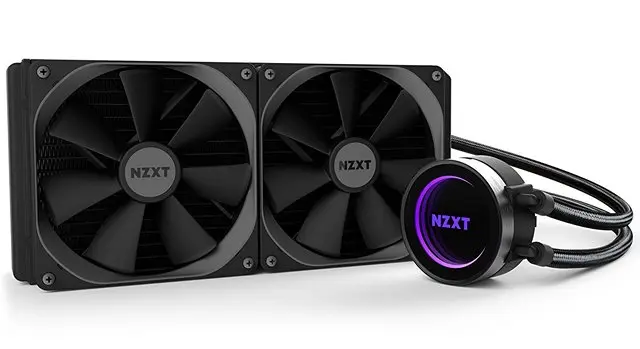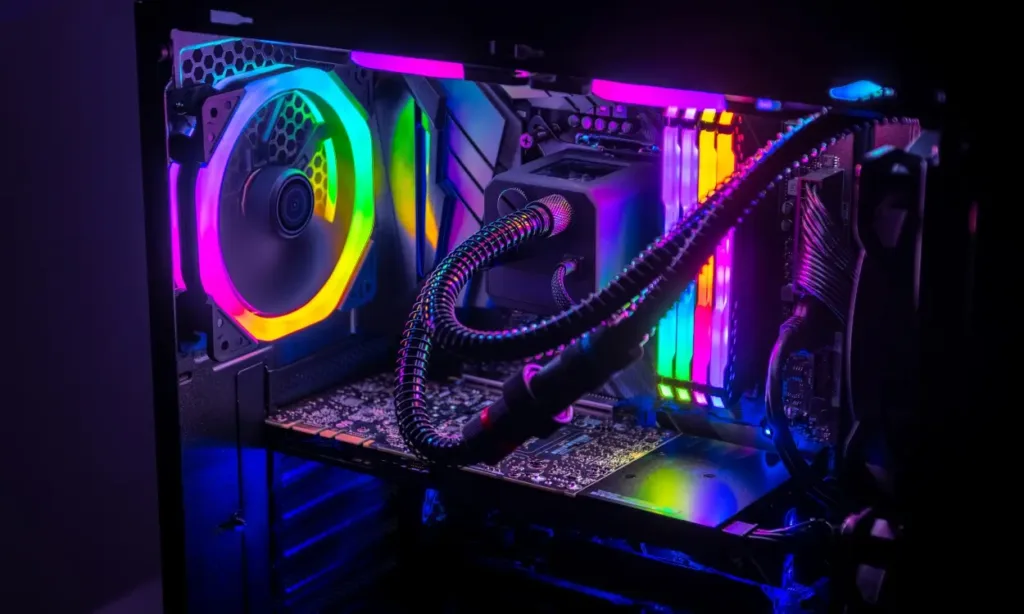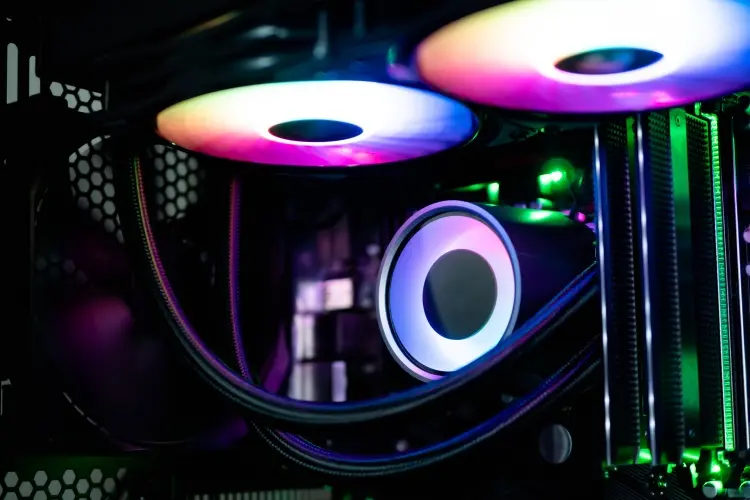
Modern CPUs consume considerable power and consequently generate substantial heat, requiring effective cooling solutions to maximize their performance. Whether you’re gaming, video editing, or just browsing, the decision often comes down to traditional air cooling versus liquid cooling.
Various factors influence this choice, such as cost, noise levels, performance, compatibility, reliability, and maintenance requirements. To assist you in making an informed decision, we’ve compared the advantages and disadvantages of all-in-one (AIO) liquid coolers and air coolers in this guide.
Liquid Cooling vs Air Cooling: How Does CPU Cooling Work?
Air coolers utilize a baseplate with heat pipes that make direct contact with the processor. Thermal paste is applied between the CPU cooler and the CPU to ensure efficient heat conduction. As the CPU heats up, so do the heat pipes, transferring the heat to the heatsink.
Cooling is achieved by passing air through the cooling fans. Air coolers can feature multiple fans of varying sizes, such as 90mm, 120mm, or 140mm. Similarly, when installing an AIO liquid cooler, one of the best thermal paste options is applied, and the baseplate makes direct contact with the processor through this paste.

In contrast, a liquid cooler operates differently. It consists of a pump, radiator, and a liquid coolant inside the pipes. The coolant continuously circulates through the pipes and is actively cooled by the fans on the radiator, providing efficient heat transfer and cooling for the processor.

Liquid Cooling vs Air Cooling: What Makes More Noise?
When it comes to noise levels, an air cooler with a higher TDP capability, like 250W, will generally be louder than a liquid cooling solution with similar cooling capacity. If you prefer a quieter PC build, a liquid cooler would be a better choice, although it will still produce some noise from the fans, especially at higher speeds.
To achieve quieter cooling with a liquid cooler, you can opt for a larger radiator size, which allows for more fans. For example, a high-end AIO liquid cooler with a 360mm radiator would likely operate at quieter noise levels compared to one with a 240mm radiator.
Overall, liquid cooling tends to be quieter, but there are also high-quality, low-noise air coolers available from reputable brands like Noctua and Deepcool.
Liquid Cooling vs Air Cooling: Performance
Every AIO liquid cooler or air cooler has a specific maximum cooling capability, typically measured in watts (W). For instance, the Lian-Li Galahad II Trinity ($178.99 on Amazon), which I use on Test Bench for CPU reviews like the 14th-Gen Intel Core i9-14900K, has a peak cooling performance of approximately 338W, maintaining the CPU temperature below 101 degrees Celsius.
Being a 360mm AIO liquid cooler, the Lian Li Galahad’s performance is impressive, but larger coolers like 420mm AIOs can achieve even higher peak performance. Nonetheless, the Galahad is capable of handling some of the most powerful desktop processors available today.

Both Intel and AMD typically recommend a 360mm AIO liquid cooler for higher-end desktop processors like the Core i9 and Ryzen 9, respectively, as these coolers can effectively manage the power consumption of these chips.
In terms of air cooling, the Deepcool Assassin IV is a visually appealing, high-performance CPU cooler with a 280W TDP. I’ve personally tested it on my friend’s build and found that it performs well with the Core i9-14900K, which has a 253W boost TDP and can reach up to approximately 279W under sustained load, as demonstrated in our review. This indicates that even high-end processors like the Intel 14th-Gen Core i9 can function efficiently with an air cooler.
Both liquid cooling and air cooling offer high-performance options that can handle top-tier processors with high power consumption. For users looking to invest more, custom liquid cooling solutions with even greater cooling performance are available.
Liquid cooling is generally considered superior to air cooling, offering potentially greater efficiency and quieter operation. However, air cooling is still capable of meeting the demands of high-end processors.
Liquid Cooling vs Air Cooling: Compatibility
Compatibility is a crucial factor to consider when purchasing a CPU cooler for your PC build. You should consider the thermal performance required by your CPU, which is indicated by its power consumption in the TDP section of the specifications page for your Intel or AMD desktop processor. Based on this, you can choose from compatible CPU cooler options, which can be either air-based or liquid-based solutions.
Additionally, you need to ensure that the cooler provides enough clearance for other components on your motherboard, such as RAM modules, VRM heatsinks, or even an M.2 SSD with a heatsink. When I was selecting a CPU cooler for my ASUS ROG B760i LGA 1700 Intel motherboard, I encountered some complexities. Although the motherboard seemed more suited for AIO liquid coolers, I needed an air cooler for reasons I will explain in the next section.

In terms of compatibility, AIO liquid coolers are typically more versatile than air coolers. The large size of high-performance air coolers can sometimes pose a problem, as they may not fit in all PC cases. This size issue can lead to incompatibility with components such as tall heatsinks or larger RAM modules.
Even a 14th-Gen Intel Core i5 desktop CPU requires a CPU cooler with a cooling capacity of 181W for it to operate at its advertised speeds. For most users, a 240mm or 360mm AIO liquid cooler is often a better choice than air coolers, based on what their PC case can accommodate.
Overall, liquid coolers generally offer better compatibility, provided the radiator can fit in the PC case. The water block installed on the CPU is designed not to interfere with the height of the RAM or the VRM heatsink, unlike many air coolers. Nonetheless, it’s important to thoroughly check compatibility before selecting a CPU cooler and to consider looking at other users’ builds to confirm compatibility with the rest of your components.
Liquid Cooling vs Air Cooling: Reliability & Maintenance
The reliability of an AIO liquid cooler can vary depending on the manufacturer, but let’s consider a modern generation liquid cooler from reputable manufacturers like Corsair, Arctic, Deepcool, or Lian Li. In terms of long-term support, these manufacturers typically offer warranties ranging from 3 to 5-6 years, depending on the model.
During this warranty period, as long as there is no intentional damage to the AIO liquid cooler, any component such as the pump, radiator, or lighting that ceases to function should be covered.
Modern AIOs are equipped with reliable pumps, and instances of coolant leakage are extremely rare. Unless you frequently move your PC with the AIO liquid cooler installed, there should be no reason for your CPU cooler to malfunction. Overall, AIOs offer a good level of reliability, and many recommended models come with warranties of up to 5 years.

However, it’s important to consider that liquid coolers have more moving parts than air coolers, which can result in lower overall reliability compared to air coolers.
With air coolers, the only components that can fail are the fans. The heat pipes and heatsink can last a very long time. In fact, some CPU cooler manufacturers offer mounts for new motherboard sockets, such as Intel LGA 1700 and AMD AM5, allowing users to use their old air coolers with their new builds.
For those who frequently move their PC, I would recommend air coolers over liquid coolers. I once had a liquid cooler fail on me after traveling with my PC, and since then, I’ve always opted for air-based cooling solutions for my builds. In my personal experience, air-based cooling solutions have proven to be more reliable.
Liquid Cooling vs Air Cooling: Which Costs More?
If you’re in search of a high-performance CPU cooling solution, Thermalright recently launched a new air cooler priced under $50. Moreover, there are many budget-friendly CPU coolers that offer exceptional performance for processors such as the Core i7-14700K or Core i5-14600K.
For high-end processors like the Core i9-14900K, which consumes 253W of power, the Deepcool Assassin IV ($99.99 on Amazon) can be an ideal choice, as it can effectively cool up to 280W. Air cooling is a suitable and more cost-effective option compared to an AIO liquid cooler. However, there are plenty of value-for-money liquid cooler options available on the market as well.
An example of such a deal is the non-RGB variant of Arctic’s Liquid Freezer III, which typically retails for under $100. It can effectively cool a CPU with a TDP of up to 250-300W, such as the Core i9 mentioned earlier, without experiencing significant thermal throttling, provided no additional overclocking is applied. It truly offers great value from a cost standpoint.
AIO liquid coolers can become quite expensive depending on the desired features. Some come with LCD displays and premium fans. However, there are also several value-for-money options available from a performance standpoint, similar to the one mentioned above.
In essence, air coolers are more readily available and affordable for processors that require less than 200W of cooling performance. However, for higher-end processors, a value-for-money AIO liquid cooler can be a very attractive option as well. It’s worth noting that not all liquid coolers are expensive, and there are affordable options in both categories.
What are your opinions on liquid coolers versus air coolers for CPU cooling? We welcome your thoughts and comments below!

0 Comments